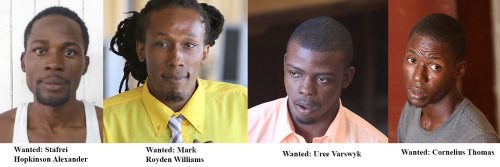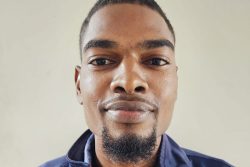The number of Camp Street Prison inmates unaccounted for after Sunday’s breakout stands at eight, according to Director of Prisons Gladwyn Samuels, who also said yesterday that the four masterminds took a service revolver from a warder.
In wake of the destruction of the prison, officials had initially said that five inmates were missing.
Samuels told Stabroek News that up to early Monday morning, the number of inmates who were unaccounted for stood at nine but one of them, murder accused Shamudeen Mohamed, was recaptured late Monday night at Tuschen, East Bank Essequibo. There was no word from the authorities yesterday on the manhunt for the escapees – particularly the masterminds.
So far, four of the missing prisoners have been named as Bartica massacre convict Mark Royden Williams and murder accused Stafrei Alexander and Uree Varswyk, and accused Trinidadian drug trafficker Cornelius Thomas. The other missing prisoners have not been identified.
 Williams was in February of this year sentenced to death after being convicted on seven of the twelve counts of murder in the February 17, 2008 Bartica massacre. Alexander was charged for multiple murders, including that of Linden businesswoman Shevon Gordon, while Varswyk, a former Tactical Services Unit trainer, was last year committed to stand trial for the murder of Sterling Products Ltd. security guard Wilfred Stewart, who was shot multiple times during a foiled robbery of the East Bank Demerara establishment.
Williams was in February of this year sentenced to death after being convicted on seven of the twelve counts of murder in the February 17, 2008 Bartica massacre. Alexander was charged for multiple murders, including that of Linden businesswoman Shevon Gordon, while Varswyk, a former Tactical Services Unit trainer, was last year committed to stand trial for the murder of Sterling Products Ltd. security guard Wilfred Stewart, who was shot multiple times during a foiled robbery of the East Bank Demerara establishment.
Samuels identified the three men as the main orchestrators of the breakout and he said he believes that the fires that were set at the facility were used as a smokescreen for their escape.
Fires had been set last year as well when inmates were protesting against conditions under which they were incarcerated and the lengthy pre-trial delays. On March 3, 2016, 17 inmates, who were trapped, perished in a fire and many others were injured.
Samuels said that the roughly 1,000 prisoners that had to be relocated to Lusignan made it difficult to do a roll call but that wardens “who knew their faces” accounted for those present.
This newspaper contacted Samuels yesterday when he was examining the rubble on site and as a result he did not have the requisite records with him on who the escapees were but promised to answer all questions “after 5pm.”
When he was called, he was rushing to a joint services meeting and up to press time calls to him were not returned.
Meanwhile, the government’s Department of Public Information (DPI) yesterday noted that on Sunday, there were 1,018 prisoners registered at the Georgetown Prison, but only 980 inmates were at the prison at the time of the fire/breakout. The other 38 inmates were out of the prison on labour duties. They were returned to the location on Sunday evening and are all accounted for.
Although one prisoner escaped while the transfers were being done from Georgetown to Lusignan, he was recaptured the same night. As a result, it said a total of 1,010 prisoners from the Georgetown Prison are accounted for. “Of the 1,010 inmates some were moved to Mazaruni while the majority remain at Lusignan at this time,” it said, while adding that an official announcement by the police force was expected last evening on the missing prisoners.
‘Well-orchestrated’
Four escapees were recorded by CCTV cameras surrounding the prison. Their feeds are not relayed to the prison’s surveillance room, which only received feeds from cameras located at various points in the prison and on its fence.
A prison warden, who was on-duty at the time the unrest started, said that it seems that the masterminds planned their escape for Sunday because of the reduced traffic around the prison and by extension the capital.
The warden, who spoke on condition of anonymity, related that while none of the wardens located at the main gate knew exactly when the first set of prisoners broke out of their cells, it was “a few minutes to four [4pm]” when they heard what sounded like “things crashing.” Shortly after, the alarm went off.
“We can’t say exactly [when] but like it was in the condemned section. From at the front you can’t really hear exactly what is going on at the back but now it seems that they like they used the improvised weapons they had and hit out the boards and break out. We didn’t even know they had all that going on. Then them … in the strong cell [which holds on remand capital offences prisoners] come out to into the yard and it must be was hard to control them. We see smoke. Same time we see prisoners running ‘Wild West’ towards we and I just drop everything and run,” the warden said.
“Looking back on everything, I believe that it was well orchestrated by those in the condemned section, mostly Williams. You have to see that boy operate. You would swear he doesn’t do some of the cruel things the other prisoners says he do until you in an area and you hear him talk with your own ears. He is very quiet and sly and would watch at you from underneath and smile but don’t let that smile fool you. Every one of us knows the influence he has on the other inmates… if he say is so, it is so and that is it,” the warden added.
Trainer
The warden told of Varswyk often boasting that he was a trainer of police officers and that he knew the logistics of the country well. He said that many times persons believed that he was embellishing his knowledge because “life was not easy for any old police in the jail. So he had to make up to get that image.”
This newspaper had arrived shortly after 4pm on Sunday and several armed prison wardens were seen outside of the jail. One with blood on his clothes told Stabroek News that there had been an altercation between the wardens and some of the prisoners and one of the officers was relieved of his gun and held hostage.
A gunfight subsequently ensued and one of the prison wardens was shot, another one chopped and four of the prisoners escaped.
According to two kitchen staffers, it was during the scheduled dinner feeding that the prisoners launched their attack. They recounted that the attack began around 3 pm.
“It was feeding time and they were all coming out and it was a vulnerable time when they catch we. The cells were open. They staged it,” one of the women said.
“I woulda be a dead woman. One had a long juka (a sharp pointed object) to my face but is good thing I don’t deal badly with jail man,” another of the women added.
Recounting their experiences, the women said they had to climb walls and the fence to get out and a few prisoners assisted them to escape.
The woman said as the attack ensued, a prisoner ran into the office of a prison warden, who they identified as Hubert Trim and started chopping him. “He was off guard and they go ’til to his office. I don’t know is wha Trim do them I don’t know,” she said sympathetically.
Trim, who was the Officer-in-Charge on Sunday, remains in the Intensive Care Unit at the Georgetown Public Hospital Corporation (GPHC). Four others who were injured, Jason Maltay, Peter Gonsalves, Earl Barthness and Simeon Sandy, were all discharged from hospital yesterday. The injured were either shot or chopped or both.
One prison warden, Odinga Wickham, was shot multiple times to the body and he died while receiving treatment at the GPHC.
A warden yesterday pointed out that Trim was stern and would not be compromised and that was why “most of the hardened criminals hated him.” He said that when on duty, Trim ensured that the prisoners followed directions and would often order “shake downs,” which led to the discovery of contraband.
Wickham, who worked in the Information Technology section, was not a duty officer. On Sunday, he was preparing computers for a programme to teach inmates. His colleagues believe that was trying to escape, since he was in an office on the top flat of the administrative building at the time the riot started.
This newspaper understands that the wooden sections were still being used to house inmates at the prison because a 200-cell concrete building to the northern side was still under construction.
Samuels said that construction workers are working around the clock trying to complete the concrete prison.
When an official was asked why condemned prisoners are not sent to the Mazaruni Prison and are instead housed at in the wooden structure created for them since 1884, he informed that Mazaruni does not have the capacity.
“Unlike what many people think, Mazaruni is not as safe as Camp Street. They don’t have the capacity in many ways to hold, who we would call very dangerous prisoners. They would not be able to handle the bad eggs who would want to start up riots and things like that… well, you might say neither did we but I am telling you that there is different and you have to go to see. The prisoners there are easier to control and they do not give the type of stress these in capital and condemnees (sic) give,” the official said, while informing that there were 25 inmates on death row up to Sunday.
“The wood was always a problem and every day you came to work you just had to say your prayers and pray that they don’t hold one head one day and decide to rip this place apart with their hands. I mean come on, old wood with 1,000 prisoners whose adrenaline running and are desperate to see the other side of the fence…what else do you expect?” the warden added.










